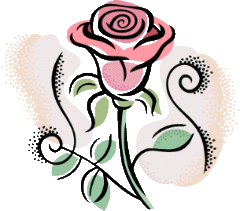
Farm & Garden Center |
Established in downtown Fredericksburg, Virginia since 1929. Knowledgeable Staff - Quality Products |

Farm & Garden Center |
Established in downtown Fredericksburg, Virginia since 1929. Knowledgeable Staff - Quality Products |
|
|
|
|
|
|
|
|
|
|
 |
SELECTION: There are 3 GRADES OF ROSES.
CLASSES OF ROSES:Grade 2 - one stem and fairly poor development.
Reds and pinks are generally more disease resistant and winter hardy than white and yellow in the tea roses.
PLANTING:
Dig a hole 18 inches
to 24 inches wide and 12 inches to 18 inches deep. Soil should contain
approximately 50% humus (such as peat, composted manure or compost) 50%
of the original soil and a handful of bone meal. Always spread the
roots in the planting hole. Bottom of the bud graft should be 1 inch
above soil.
FEEDING:
Recommended feeding
schedule might be:
1. Early spring (April 1)
2. At the close of June blooming.
3. Not later than 2 months prior to dormancy.
Fertilizing late in the season (after mid September) stimulates tender growth, which will be damaged by winter. Slow release fertilizers (Osmocote or Mills Magic Rose Mix) may be used for the convenience of infrequent feeding. Another method would be to fertilize once a month from April 1 through September 1 with a dry form of rose food.
WATERING:
Use a regular watering
schedule (as needed) is the most important factor in the health of roses.
We recommend watering once a week when adequate rainfall is missing.
A healthy plant gives maximum bloom, suffers less disease and sustains
winter cold and summer heat with less damage.
MULCHING:
Mulch to 2 inches during
growing season to help retain moisture. Porous mulch i.e. pine bark
or pine needles are good choices.
PRUNING:
Spring: Prune
before spring growth begins - in Fredericksburg (this is April 1).
Prune teas and floribundas back to 4 to 6 strong canes with a length of
12 to 18 inches. Some Climbers bloom on previous season's growth
and should be limited to the removal of unwanted growth and renewal (cutting
out some old canes).
Summer: Prune off old blooms (dead heading) to encourage production of new blooms rather than seed. Most pruning for shape should be done when blooms are cut. Normally, cuts should be made just above the first or, at most, the second five leaflet leaf. Suckers than grow from below the crown should be cut out at the socket.
Winter: Prune December 1st. to 36 inches.
DISEASE & PESTS:
Roses are a favorite
of Japanese beetles and aphids as well as black spot. You may prevent
these by using Sevin for the chewers (beetles) and Orthene or Merit for
the suckers (aphids, mites). You may prevent disease by using Daconil
or Funginex. A good spray schedule might be every other week beginning
early April. Take care not to spray too often with insecticide as
this may burn foliage. A product called Orthonex is popular and effective
because it contains two systemics - Orthene for bugs and Funginex for diseases.
Add Sevin during the beetle swarm and you'll probably be fine. These
products can often be mixed for spraying; check package directions and/or
your dealer.
Resources:
Roses by Roy E.
Shepard, Rinehart & Co., Inc., 1954
Growing Better Roses
by Fred J. Nisbet, Alfred A. Knopf, Inc., 1973
Roxbury Farm & Garden
Center
Fredericksburg, VA.
22401
updated: 02-05-01